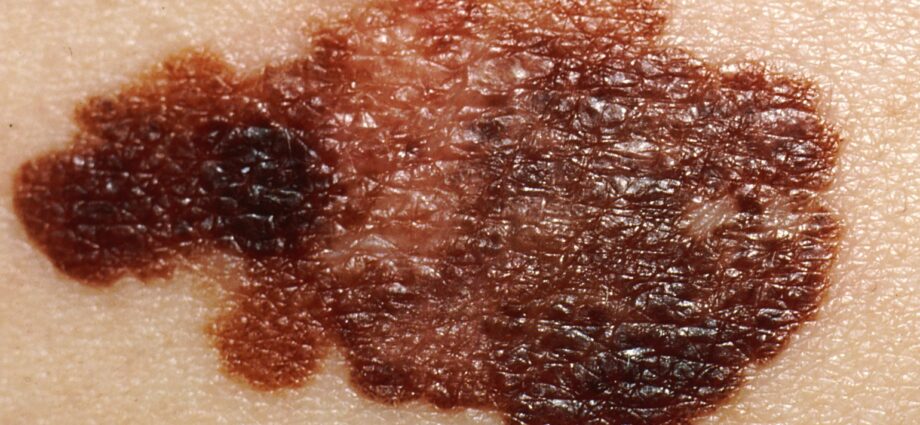Contents
Melanoma
Melanoma is a cancer of the skin that is mainly linked to overexposure to ultraviolet rays. We sometimes speak of “malignant melanoma” in everyday language.
What is melanoma?
Definition of melanoma
Melanoma is skin cancer, which is a malignant tumor that develops from skin cells. In this case, it is the cells that make melanin (a pigment that gives color to the skin, hair and hair): the melanocytes.
The development of a melanoma is first superficial in the epidermis. We speak of melanoma in situ. When it continues to spread, the melanoma will grow in depth. It is then said that the cancer is invasive. At this stage, cancer cells can break away from the original tumor, colonize other areas of the body and cause metastases (secondary cancers).
Melanomas tend to appear in exposed areas of the skin because UV rays are a major risk factor. However, some shapes can appear in unexposed areas. There are four main forms of melanoma:
- superficial extensive melanoma (between 60 and 70% of cases) which is associated with the development of severe sunburn in the past;
- Dubreuilh’s melanoma or lentigo-malignant melanoma (between 5 and 10% of cases) which is associated with repeated exposure to ultraviolet (UV) rays;
- lumpy melanoma (less than 5% of cases) which evolves rapidly and can appear on any part of the skin, even unexposed areas;
- acrolentiginous melanoma or melanoma of the extremities which is not associated with overexposure to UV rays and is generally seen in people with dark skin.
Causes and risk factors of melanoma
The development of melanoma is mainly associated with the presence of risk factors. Among them are:
- exposure to UV rays, both solar and artificial;
- a history of sunburn, mainly during childhood;
- fair skin;
- sensitivity to the sun;
- the significant presence of moles, estimated at more than 50 moles;
- the presence of unusual looking or large congenital moles;
- a history of skin cancer which may be personal or family;
- immunosuppression, that is, the weakening of the immune system.
Diagnosis of melanoma
Melanoma can be suspected if a mole changes quickly or if a suspicious lesion appears (usually an irregular spot). A rule has been established to recognize an abnormal skin patch. This rule defines 5 “ABCDE” criteria:
- A for Asymmetry which defines a spot of irregular shape neither round nor oval and having colors and reliefs irregularly around its center;
- B for Irregular Edges which defines a stain with poorly defined and irregular edges;
- C for Non-homogeneous color which defines the presence of different colors (black, blue, red brown or white) in a disorderly fashion within the spot;
- D for Diameter when the spot has a diameter greater than 6 mm;
- E for Evolution with a stain that quickly changes size, shape, color or thickness.
The observation of one or more of these signs does not always mean that there is a melanoma. However, it requires a medical appointment to be made as soon as possible in order to carry out a thorough examination.
The thorough examination is carried out by a dermatologist. If melanoma is suspected, visual examination is supplemented by diagnostic resection. The latter consists of a tissue sample for analysis. The results of the analysis confirm the melanoma and define its stage of development.
Depending on the course of the melanoma, medical imaging examinations may be performed to assess the extent and adapt the management.
People affected by melanoma
Melanoma accounts for 10% of skin cancers. The figures show that it is the cancer with the largest increase in the number of new cases per year. In 2012, its incidence was estimated at 11 cases. It is diagnosed at an average age of 176 and appears to be slightly more common in women than men.
Symptoms of melanoma
Melanoma presents on the skin as a pigmented spot. In 80% of cases, melanomas develop from “healthy skin” that has no lesions or spots. Their development leads to the appearance of a pigmented spot in the shape of a mole. In other cases, melanomas develop from an already existing mole (nevus).
Treatments for melanoma
Depending on the case, the management may be based on one or more different treatments. Surgery, drug treatment, and radiation therapy may be considered to destroy cancer cells.
Most often, the management of melanoma is surgical. It also happens that the resection performed for the diagnosis is sufficient to remove the tumor in its entirety.
Prevent melanoma
It is recognized that the main risk factor for melanoma is overexposure to UV rays. Prevention consists in particular of:
- limit exposure to the sun, especially during the hottest hours;
- protect yourself by applying a barrier cream and protective clothing;
- avoid artificial tanning in the cabin.
Early detection of melanoma is also essential to limit its development and prevent complications. It is recommended that you perform a regular self-examination of your skin using the criteria of the “ABCDE” rule presented above. A loved one can assist with the examination for inaccessible areas. In case of doubt and for a more complete examination, consultation with a health professional is essential.










